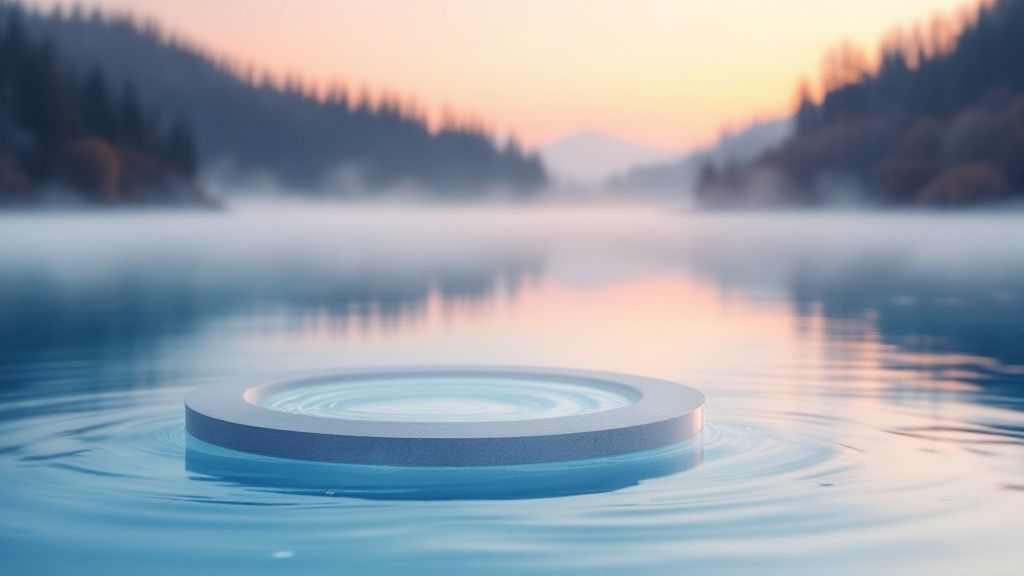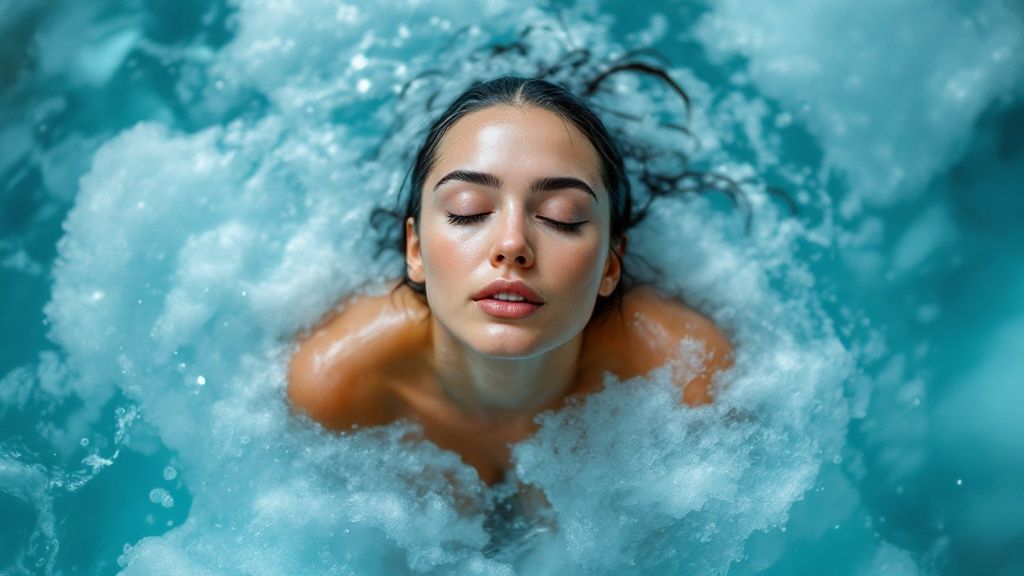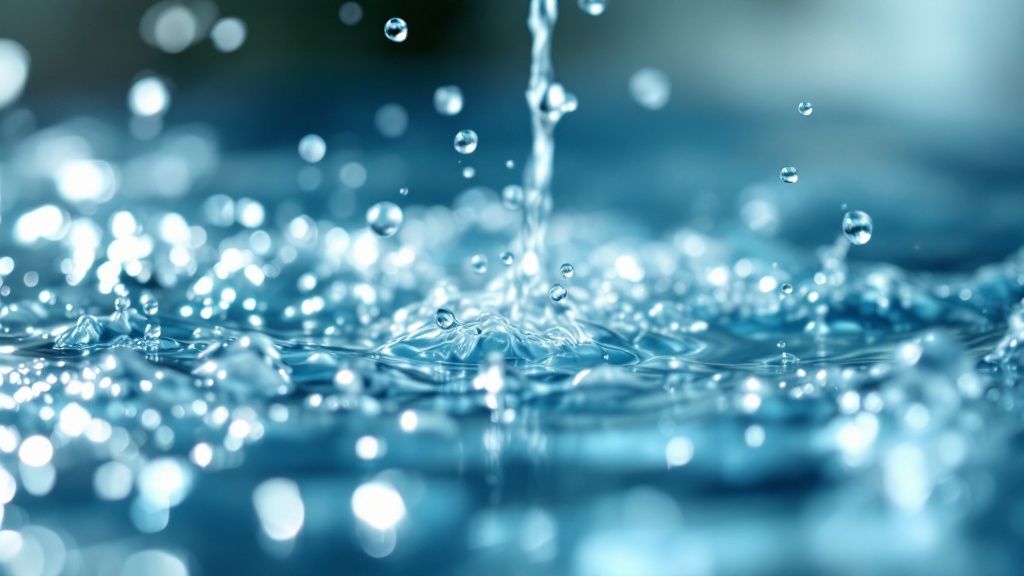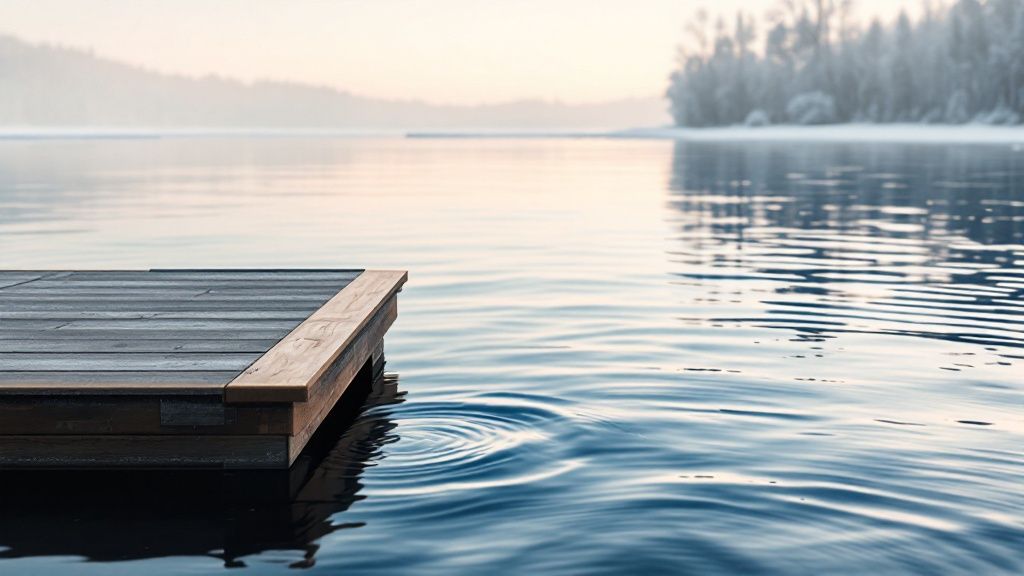Ancient Wisdom: The Surprising Origins of Cold Plunge Therapy

The invigorating chill of a cold plunge isn't a new wellness practice. Its origins can be traced back thousands of years to ancient cultures who understood the inherent power of cold water immersion. These early practitioners, without the advanced scientific knowledge we possess today, intuitively recognized the therapeutic potential of cold exposure. This formed the basis for the cold plunge therapy we're familiar with now.
Early Uses of Cold Water Immersion
Evidence suggests that ancient civilizations, including the Egyptians, understood and utilized the benefits of cold water. The Edwin Smith Papyrus, dating back to approximately 3500 BCE, details the therapeutic application of cold water. Cold water was considered a valuable tool for improving vitality and combating illness. The ancient Egyptians, for example, used cold water to address various ailments.
This early recognition underscores the enduring power of cold water for health and well-being. As societies progressed, so did the application of cold water therapies. These therapies eventually incorporated elements like hydrotherapy, which gained popularity during the 19th and 20th centuries. Discover more insights about the history of cold therapy. Today, people around the globe use cold plunges for both physical recovery and mental wellness.
The Greek and Roman Approach to Cold Therapy
The ancient Greeks, known for their emphasis on physical and mental wellness, incorporated cold water into their health practices. They observed its efficacy in reducing inflammation and promoting athletic recovery after intense physical activity. This historical practice laid the foundation for the widespread use of cold therapy among athletes and fitness enthusiasts today.
The Romans also embraced cold water immersion. They frequently incorporated elaborate cold baths and frigidariums into their public bathhouses. These communal areas weren't just for hygiene; they also served as social gathering places and provided the health benefits associated with cold exposure.
Cold Plunge: A Bridge Between Ancient Wisdom and Modern Science
The continued interest in cold plunges highlights the connection between traditional healing practices and modern scientific validation. What ancient civilizations intuitively understood, we are now beginning to understand through scientific research. This research is providing more in-depth knowledge of the mechanisms and benefits associated with this age-old practice.
The growing body of research is further connecting ancient wisdom with modern science. This renewed focus on cold plunge therapy emphasizes the time-tested wisdom of incorporating natural elements into wellness practices. The next section will explore the evolution of cold plunging from a relatively niche practice to its current position as a mainstream wellness trend.
From Obscurity to Mainstream: The Cold Plunge Revolution

While cold water immersion has roots in ancient cultures, it was the 19th century that truly reignited interest in the practice, paving the way for the modern cold plunge movement. This era witnessed remarkable progress in hydrotherapy, establishing the foundation for many wellness practices we utilize today.
The 19th century became a pivotal moment for hydrotherapy thanks to individuals like Vincent Priessnitz and Sebastian Kneipp. In the early 1800s, Priessnitz established the first hydrotherapy clinic in Grafenberg, Austria. His cold-water treatments gained immense popularity and became the cornerstone of modern hydrotherapy. Kneipp further developed these practices by integrating cold water with herbal remedies and physical activity, shaping modern naturopathic approaches. These advancements underscore the historical significance of cold water therapy within European wellness traditions. Explore this topic further.
The Rise of Cold Plunging in Athletics
Long before cold plunging became a widespread trend, elite athletes recognized its potential for recovery. For decades, they quietly incorporated it into their training regimens. This adoption by top performers helped shift the perception of cold plunging from a niche activity to a respected recovery method.
This change played a significant role in the growing interest in cold plunges among the wider fitness community. More people began to explore the advantages of cold water immersion for their post-workout recovery.
Social Media and the Modern Cold Plunge Movement
Social media has undeniably played a critical role in bringing cold plunging to the mainstream. Influential figures sharing their experiences with cold water immersion generated considerable excitement around the practice. Platforms like Instagram and TikTok showcased the purported benefits, further establishing the cold plunge as a key component of modern wellness.
This increased visibility introduced cold plunging to a broader audience and accelerated its adoption. The rapid growth reflects a general trend of people seeking natural and accessible ways to improve their overall well-being.
The Science Behind the Plunge
As cold plunging gained popularity, scientific research began to investigate its potential benefits. Studies exploring the effects of cold water immersion on inflammation, circulation, and recovery provided scientific support for what practitioners had long observed.
This research solidified cold plunging's position as a legitimate wellness practice backed by evidence, moving it beyond a simple fad. This validation has continued to fuel the cold plunge revolution, inspiring more people to explore its potential advantages.
Beyond the Hype: Real Benefits of Cold Plunge Therapy

Cold plunge therapy is making waves in the wellness world. But what's the real story behind the invigorating chill? This section dives into the science-backed benefits of cold plunges, exploring their effects on both body and mind.
How Cold Plunging Affects Your Body
Taking a cold plunge sets off a chain reaction within your body. One key effect is the activation of the sympathetic nervous system, your body's "fight-or-flight" response. This triggers the release of norepinephrine, a hormone and neurotransmitter associated with increased alertness and focus. Cold exposure can also activate brown fat, a type of fat that burns calories to produce heat, potentially benefiting metabolic health.
Cold plunges also influence your circulation. Initially, blood vessels constrict (vasoconstriction), followed by widening (vasodilation) as you warm up. This can improve blood flow and possibly reduce inflammation. Researchers are also exploring the effects of cold plunges on the immune system, with some studies suggesting a potential increase in immune cell activity. Further research is needed to fully understand these effects.
To illustrate the impact of cold plunges on various body systems, let's look at the table below:
Cold Plunge Benefits by Body System
A comprehensive breakdown of how cold water immersion affects different physiological systems
Body System | Cold Plunge Effect | Scientific Evidence Level |
|---|---|---|
Nervous System | Activates sympathetic nervous system, releases norepinephrine | Strong |
Endocrine System | May activate brown fat, potentially improving metabolic health | Moderate |
Circulatory System | Causes vasoconstriction followed by vasodilation, potentially improving blood flow and reducing inflammation | Moderate |
Immune System | May boost immune cell activity | Emerging |
As this table shows, the effects of cold plunges are multifaceted and warrant further investigation. While the evidence is strong for certain benefits, like the activation of the sympathetic nervous system, more research is needed to solidify our understanding of other potential advantages.
Cold Plunge and Mental Health
The advantages of cold plunges extend beyond the physical. Emerging research suggests a potential link between regular cold exposure and improved mental well-being. The release of endorphins during and after a cold plunge can elevate mood. Some studies also suggest that cold plunges may enhance stress resilience and even help manage symptoms of anxiety and depression.
For instance, one small study revealed that regular cold water immersion lessened depressive symptoms in participants. While these findings are promising, more research is needed to fully understand the connection between cold plunges and mental health. Cold plunges offer a potential complementary approach to supporting mental health, but they should not replace professional treatment.
Cold Plunge for Recovery and Performance
Athletes and fitness enthusiasts have long used cold plunges for recovery. Cold water immersion can help reduce muscle soreness and inflammation post-workout. The restricted blood flow to the muscles can minimize swelling and tissue breakdown. This is particularly helpful for those involved in high-impact activities.
The potential of cold plunges to improve circulation might also contribute to faster recovery by clearing metabolic waste from muscles. However, the long-term effects of cold plunges on strength training adaptations are still being researched. Some studies suggest that regular cold water immersion after resistance training may potentially hinder muscle growth.
Evidence-Based Benefits: Separating Fact from Fiction
While anecdotal evidence praises cold plunge therapy, it's important to look at the scientific research.
Reduced Muscle Soreness: Studies confirm that cold water immersion effectively reduces delayed-onset muscle soreness (DOMS) after intense exercise.
Improved Mood: Cold plunges trigger the release of endorphins, known to boost mood. More research is needed to explore the long-term impact on mental well-being.
Reduced Inflammation: The effect of cold plunges on inflammation is still being studied. Some studies indicate a positive effect, but further research is required.
The benefits of cold plunges are a subject of ongoing research, which will provide a clearer understanding of their role in promoting both physical and mental well-being. This growing body of knowledge empowers individuals to make informed decisions about incorporating cold plunge therapy into their wellness routines.
Your First Cold Plunge: A Practical Getting Started Guide

So, you're thinking about trying cold plunge therapy? This guide will walk you through your first experience, ensuring it's both safe and effective. Preparing your mind and body for the initial shock is key.
Preparing For Your First Cold Plunge
Before jumping in, it's a good idea to get your body used to colder temperatures. Try adding cold showers to your daily routine. Gradually lower the water temperature over a few days or weeks. This helps your body acclimate to the cold and lessens the initial shock of a full cold plunge.
Also, schedule your first cold plunge for a time when you're feeling calm and relaxed. Stress can intensify your body's reaction to cold. Picking a peaceful moment makes the experience easier.
Managing The Initial Shock: Breathing Techniques
The initial plunge can feel intense. Controlled breathing helps manage this shock. Practice deep, slow breaths before, during, and after your cold plunge. This regulates your heart rate and reduces the breathless feeling that can happen when you first enter the cold water.
For example, try the box breathing method: inhale for a count of four, hold for four, exhale for four, and hold for four. This technique is often used by Navy SEALs to handle the stress response to sudden cold.
Building Cold Tolerance Systematically
Like anything new, consistency and a gradual approach are important for building cold tolerance. Start with short cold plunges, maybe 1-2 minutes. As you feel more comfortable, slowly add time, increasing by 30 seconds to a minute each session.
Avoid pushing yourself too hard, especially at first. Listen to your body. If you begin to shiver uncontrollably or feel any discomfort beyond the initial shock, get out of the plunge right away. Regular, shorter plunges are better than infrequent, long ones.
Choosing The Right Cold Plunge Setup
The right setup is crucial for a consistent cold plunge practice. There are several options depending on your budget and available space. To help track progress you could use an app like Sauna Tracker. Although, meant for sauna use you could manually log plunges to keep your activities organized.
Budget-Friendly Options: An ice bath in your own bathtub is a great place to start. Add ice bags or frozen water bottles to reach the temperature you want.
Portable Cold Plunge Tubs: These are designed specifically for cold plunges and give you more control over the temperature.
High-End Cold Plunge Tanks: These tanks have advanced features like temperature control and filtration. They are more expensive, but they offer a more convenient and controlled experience.
Think about your individual needs and resources when choosing a setup. A comfortable and easy-to-use setup will help you maintain a regular routine.
Cold Plunge Temperature Guide
The best temperature for a cold plunge depends on your experience level. This table provides a general guide:
To help guide your cold plunge experience, use the table below for recommendations.
Cold Plunge Temperature Guide
Recommended temperatures and exposure times based on experience level and goals
Experience Level | Temperature Range (°F) | Exposure Time (minutes) | Best For |
|---|---|---|---|
Beginner | 50-60 | 1-2 | Initial acclimation, reducing inflammation |
Intermediate | 45-55 | 2-5 | Enhanced recovery, boosting mood |
Advanced | 35-45 | 5-10 | Maximum benefits, increased cold tolerance |
Pay attention to how your body responds and adjust the temperature and time as needed.
Incorporating Cold Plunge Into Your Routine
To make cold plunges a regular habit, integrate them into your schedule. Set a consistent time, whether it’s first thing in the morning, after a workout, or before bed. Treat it like any other appointment.
Even short plunges are beneficial if you're short on time. Consistency is key. Finding a time that works for you and maintaining that schedule will maximize the benefits of cold plunge therapy in the long run.
Cold Plunge vs. Other Recovery Methods: What Works Best?
Recovery is crucial for anyone pushing their physical and mental limits. With so many options, from cold plunges to saunas, finding the best recovery method can feel overwhelming. This section compares cold plunge therapy with other popular recovery methods to help you create a personalized recovery plan.
Cold Plunge vs. Active Recovery
Active recovery, such as light jogging or stretching, increases blood flow and helps clear metabolic waste. While cold plunges primarily reduce inflammation and ease soreness, active recovery gently works the muscles. For instance, after an intense run, a light walk might reduce stiffness while a cold plunge minimizes inflammation. This makes them complementary recovery practices.
Cold Plunge vs. Sauna
Cold plunges and saunas offer unique benefits and create a powerful synergy when used together. A cold plunge reduces inflammation and muscle soreness, while a sauna promotes relaxation and detoxification through sweating. Alternating between these extremes, similar to contrast therapy, can improve circulation and cardiovascular health, making them a powerful combination for wellness. The Sauna Tracker app is a valuable tool for monitoring sauna sessions and optimizing their benefits.
Cold Plunge vs. Compression Therapy
Compression therapy, using compression socks or sleeves, enhances blood flow and lymphatic drainage. It reduces swelling and can improve recovery time. Both compression therapy and cold plunges offer circulatory benefits, but cold plunges provide short-term, acute treatment for inflammation. Compression therapy provides sustained support for circulation and can be used for extended periods.
Cold Plunge vs. Massage
Massage focuses on specific muscle groups, releasing tension and improving flexibility. It can address knots and adhesions hindering recovery. Massage offers localized treatment while cold plunges have a more systemic effect on inflammation. Both benefit muscle recovery but through different mechanisms.
Cold Plunge vs. Other Modalities: Choosing the Right Combination
Other recovery modalities, including foam rolling, cryotherapy, and electrolyte supplementation, offer unique benefits. Foam rolling addresses muscle tightness and improves mobility. Cryotherapy, like whole-body cryotherapy, involves intense cold exposure for shorter periods than cold plunges. Electrolyte supplementation replenishes essential minerals lost through exercise.
An effective recovery strategy requires understanding your specific needs and choosing methods that address them. For example, a marathon runner might combine cold plunges with compression therapy and massage to reduce muscle soreness and improve circulation. A strength athlete might use foam rolling and electrolyte supplementation alongside cold plunges to manage muscle tightness and rehydrate.
Building Your Personalized Recovery Protocol
Creating a personalized recovery protocol requires understanding your recovery goals, your individual responses to different methods, and incorporating them strategically into your routine. Consider your goals: are you focused on performance enhancement, pain management, or overall well-being? Experiment to find the best combination.
A sample recovery protocol could include a cold plunge after an intense workout followed by light stretching and foam rolling. On rest days, a sauna session followed by a cold plunge can promote relaxation and improve circulation.
By combining the strengths of each recovery method, you can create a comprehensive plan that supports your goals and optimizes your recovery. This approach enhances recovery and contributes to long-term health and wellness. Listening to your body and adapting your protocol is essential for lasting results.
Mastering the Cold: Avoiding Common Plunge Mistakes
Embarking on a cold plunge can be incredibly rewarding. It offers potential benefits ranging from reduced muscle soreness to an improved mood. However, common mistakes can hinder progress and even create risks. This section explores these pitfalls and how to avoid them, ensuring your cold plunge practice is both safe and effective.
Temperature Progression: Don't Shock the System
One of the most frequent mistakes is jumping into frigid water too quickly. This shocks the system, leading to gasping, hyperventilation, and potentially dangerous blood pressure spikes. Starting slowly is crucial. Begin with water temperatures between 50-60°F (10-15°C) and gradually decrease the temperature as your body adapts. This allows acclimation without undue stress. It's like weight training—you wouldn't start with the heaviest weight.
Breathing Techniques: Staying Calm Under Pressure
Proper breathing is essential for a safe and comfortable cold plunge. Holding your breath or shallow breathing exacerbates the stress response. Focus on deep, controlled breaths before, during, and after the plunge. The box breathing technique (inhale for 4, hold for 4, exhale for 4, hold for 4) helps regulate your nervous system and promote relaxation, making the cold more tolerable and managing physiological responses.
Recognizing Your Limits: Avoiding Overexertion
Pushing yourself too hard, especially when starting, can be counterproductive. Ignoring your body's signals can lead to shivering, numbness, and even hypothermia. Pay close attention to how you feel. If you experience intense shivering or discomfort beyond the initial cold shock, exit the plunge immediately. Find your "optimal edge"—the point where you're challenged but not overwhelmed. Shorter, more frequent cold plunges are generally more beneficial than infrequent, long sessions.
Consistency Is Key: Overcoming Motivation Challenges
Like any wellness practice, consistency is essential for maximizing the benefits of cold plunges. Motivation can be a challenge, especially with the initial discomfort. Establish a regular routine and treat your plunges like important appointments. Even short, 1-2 minute plunges are beneficial. An accountability partner or a cold plunge community can offer valuable support.
Recovery Timing: When to Plunge
Strategic timing can enhance the effectiveness of your cold plunges. Post-workout plunges are popular for reducing muscle soreness and inflammation. However, studies suggest regular cold water immersion after strength training might affect long-term muscle growth. If muscle growth is a primary goal, consider spacing out post-strength training cold plunges or incorporating other recovery methods like active recovery or massage. Find what works best for your needs and goals.
By avoiding these common mistakes and adopting a gradual, mindful approach, you can unlock the potential of cold plunge therapy. Track your progress alongside other wellness activities with the Sauna Tracker app. While primarily for sauna use, it allows manual logging of cold plunges, keeping your wellness journey organized and providing insights into your progress.

